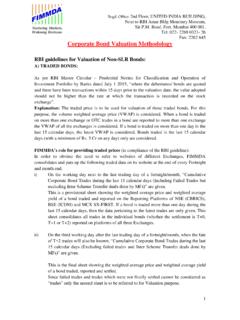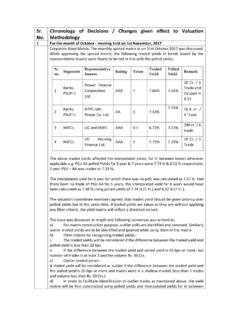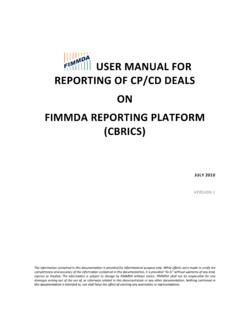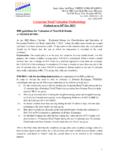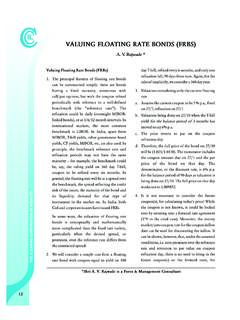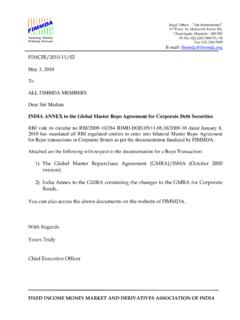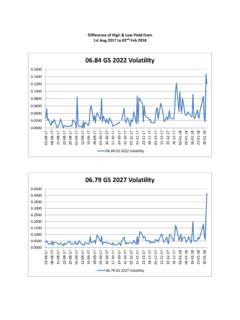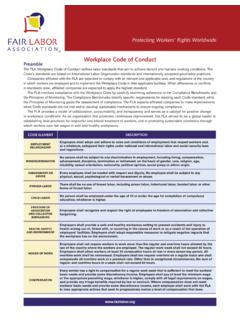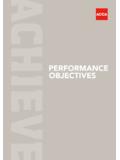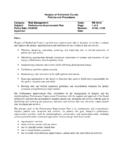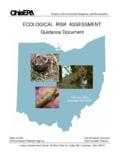Transcription of FINANCIAL BENCHMARK INDIA PVT LTD - FIMMDA
1 FINANCIAL BENCHMARK INDIA PVT LTD 1 Unified code of conduct for Submitters June, 2016 Version 1. Introduction FINANCIAL benchmarks are primarily used for pricing, valuation and settlement of FINANCIAL contracts. The robustness and reliability of the FINANCIAL benchmarks play a critical role in the stability of the FINANCIAL system. The cases of manipulation and false submissions in some major global FINANCIAL benchmarks have seriously undermined the credibility and reliability of such benchmarks, particularly about their governance frameworks and setting methodologies.
2 Long term stability and credibility of the market largely depends upon ethical practices and rules of conduct . Hence, it is expected that the contributing entities conduct their submission process judiciously, keeping in view the guidelines provided herein, and contribute to the proper setting and governance of FINANCIAL benchmarks. The code of conduct articulates guidance to strengthen the governance processes and accountability mechanism in the BENCHMARK submission and the quality of benchmarks. Contributing entities should ensure that all staff involved in the BENCHMARK submission process are given a copy of this code and are advised to comply with the same.
3 The code should also be made readily available to all staff so that they have easy and ready access to it whenever they want. The code of conduct is applicable to benchmarks that are determined through polled submissions. The BENCHMARK administrator will identify BENCHMARK specific Submitters (hence forth known as Contributing entities ). The list of submitters will be drawn by the Administrator on the basis of their standing, market-share in the BENCHMARK /instrument linked to the BENCHMARK and representative character. Such lists will generally be drawn once every year and published on the website of FIMMDA /FEDAI/IBA/the Administrator/Calculating agents (wherever appointed) under information to such entities.
4 The submitters so identified will have to necessarily contribute to the BENCHMARK submissions as per RBI guidelines contained in their circular dated April16, 2014. 2. Objectives a. To provide guidance to contributing entities in the rate submission process b. To promote discipline amongst the participants of the BENCHMARK submission process. c. To strengthen internal control in submission process. d. To increase transparency in the BENCHMARK determination process. e. Above all, to foster confidence in the BENCHMARK setting framework. 3. Organisational structure for Governance of benchmarks: A contributing entity should put in place effective organisational structure for governance of BENCHMARK submissions.
5 The structure should include senior management involved in the BENCHMARK submission process. The Governance framework will cover policies and procedures for arriving at the submissions, reporting, review and oversight of the submission process. 4. Internal Policies and procedures A Contributing entity should put in place an internal Board approved policy on governance of the BENCHMARK submission process. The policy may ensure that personnel at appropriate senior positions with requisite knowledge and expertise are responsible for BENCHMARK submission and that they are clearly accountable for the same.
6 A contributing entity should formulate a Board approved policy on conflicts of interest and implement and enforce such policies and procedures which effectively help the contributing entity in identification, management, avoidance or mitigation of existing and potential conflicts of interest. The policies may identify any new threats/conflicts that may arise due to change of business profile/products/services and take appropriate mitigation techniques that are required. A Contributing entity should put in place a whistle blowing policy so that members of staff have a means by which they can inform their concerns regarding unlawful or inappropriate practices relating to BENCHMARK submission to appropriate authorities.
7 2 A Contributing entity should have robust compliance function to ensure proper conduct of BENCHMARK submission process within their organisation. Policies should be made available to all the staff identified and associated with BENCHMARK submission process. Such policies will also be made available to the BENCHMARK Administrator and the Regulator. All policies should be reviewed periodically and updated. 5. Selection of Personnel and training: A contributing entity must ensure that all staff /seniors identified by it should have relevant knowledge/skill/experience in the markets related to the BENCHMARK for which they are responsible for making submissions/review/oversight/compliance functions.
8 All such identified staff should receive training on responsibilities, processes, systems and controls associated with benchmarks. All submitters/reviewers/members of the oversight function should receive training to ensure: a) Familiarity with the responsibilities, policies and procedures of a contributing entity. b) Familiarity with conducting business related to products that are referenced to the BENCHMARK for which submission is being done. c) That they understand and appreciate the impropriety of attempting to influence a submission, and the potential consequences thereof. d) That they are familiar with the method of reporting such attempts/actions to the senior management/ BENCHMARK administrator/regulator.
9 6. Operating procedure for arriving at BENCHMARK submission: A contributing entity should designate a group of senior individuals with responsibility for the submission.. Pre submission checks: There shall be a pre submission validation to rule out errors. Submission will have to be done by written communications or through robust contribution devices which leave an audit trail. 3 Post submission review: Once an entity makes a submission, there should be a review of the submissions by designated official/s to ensure that the submitted rates fall within the minimum variance threshold prescribed by the Contributing entity in their internal policies.
10 Any errors requiring correction or further adjustments need to be identified and rectified in future submissions. In case of considerable errors, the same may be intimated to the BENCHMARK administrator. The post submission reviews must be documented. In larger organisations, they may appoint more than one individual responsible for reviewing the submission process. The records should indicate the details of the individual(s) with names, designation, role and reporting line as well as detailed job description covering the BENCHMARK submission process. Oversight function: The contributing entity shall constitute a group of senior officials with responsibility of overseeing the BENCHMARK submission process or the oversight may be exercised within the entity s existing accountability/compliance framework as per the policies of the entity.
